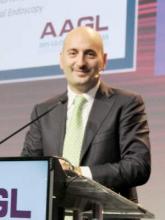LAS VEGAS – The combination of three-dimensional ultrasound and a graduated intrauterine palpator significantly increased the rate of complete metroplasties in a group of women with unexplained infertility or repeat miscarriage.
The instrument, which is marked in millimeters, allows the surgeon to more accurately gauge how much of a uterine septum is removed during the procedure, as well as approximate the shape of what is left. Combined with transvaginal ultrasound visualization, the technique makes a complete, but not overly aggressive, resection more likely, Dr. Attilio Di Spiezio Sardo said at the meeting sponsored by the AAGL.
“One of man’s dilemmas in everyday life is knowing when to stop,” said Dr. Sardo of the University of Naples “Federico II,” Italy. “The same applies to hysteroscopic metroplasties. We still don’t know where to end the incision in order to avoid complications, significant bleeding, or perforation, and in order to avoid abnormal anatomical results.”
The new data he presented builds on his 2009 work, which used 3-D transvaginal ultrasound as the basis for a new subclassification system for uterine anomalies to be used during in-office hysteroscopy.
The aim of the current study was to assess whether the addition of a 5 French graduated intrauterine palpator could improve the accuracy of hysteroscopic metroplasty, compared with that obtained without the instrument. Anatomic results were assessed by 3-D transvaginal ultrasound and second-look hysteroscopy and classified as complete (residual septum less than 5 mm), suboptimal (residual septum 5 mm-10 mm), or incomplete (residual septum greater than 10 mm).
All procedures were performed with the same initial technique under conscious sedation with a 5 mm hysteroscope and miniaturized 5 French instruments. First, the surgeon used a bipolar electrode to remove three-quarters of the septum. Blunt scissors were then used to refine the septal base.
In the intervention group, however, the intrauterine palpator was used to measure the portion of the remaining septum. The metroplasty was stopped when the intrauterine palpator showed that the resected septum corresponded to the presurgical ultrasonographic measures, and had a fundal notch of 1 cm. In the control group, the procedure was stopped when the tubal ostia were clearly visible on the same line and/or hemorrhage from small myometrial vessels of the fundus occurred.
The mean procedural time was similar in the palpator and control groups (12.6 minutes vs. 11.7 minutes). There was one postsurgical intrauterine adhesion in each group.
There were significantly more complete resections in the palpator group than the control group (71% vs. 41%), although the number of suboptimal resections was similar (28% vs. 20%). There were 12 incomplete resections, all of which were in the control group. There was no correlation between septal length and the completeness of resection, Dr. Sardo added.
The combination of 3-D transvaginal ultrasound and a graduated palpator to physically explore the intrauterine space should help improve outcomes in what can be a frustrating procedure, he said.
“I used to think my metroplasties were perfect, and then I reviewed the videos and ultrasounds and sometimes saw that part of the septum was still there,” Dr. Sardo said. “After endometrial ablation, I think hysteroscopic metroplasty is one of the most frustrating problems” for a gynecologic surgeon.
Dr. Sardo reported having no financial disclosures.


